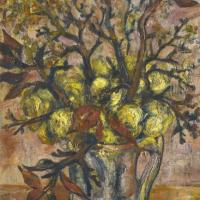Natalia Gontcharova
Fashion Design
$450.00
Natalia Goncharova
$450.00
Still Life With A Jug
$450.00
Street In Moscow
$450.00
Natalia Gontcharova
Natalia Gontcharova (1881-1962)
Natalia Sergeevna Goncharova (July 3, 1881 – October 17, 1962) was a Russian avant-garde artist, painter, costume designer, writer, illustrator, and set designer. She was a founding member of both the Jack of Diamonds, Moscow's first radical independent exhibiting group, and the art movement known as Der Blaue Reiter. Born in Russia, she moved to Paris in 1921 and lived there until her death.

Natalia Sergeevna Goncharova was born on July 3, 1881, in Nagaevo (now in the Chernsky District of Tula Oblast). Her father, Sergey Mikhaylovich Goncharov, was an architect and graduate of the prestigious Moscow Institute of Painting, Sculpture and Architecture. Goncharova moved to Moscow at the age of 10 in 1892; she graduated from the Fourth Women's Gymnasium in 1898.
In 1901 Goncharova began her own studies at the Moscow Institute of Painting, Sculpture and Architecture as a sculptor, under Pavel Trubetskoi, who was associated with the World of Art movement. By 1903, she began exhibiting in major Russian salons. She was awarded a silver medal for sculpture in 1903-04. It was at the Moscow Institute that Goncharova met fellow-student Mikhail Larionov, and not long afterwards they began sharing a studio and living space. She withdrew from the Moscow Institute in 1909, and in 1910, after a number of students were expelled from Konstantin Korovin's portrait class for imitating the contemporary style of European Modernism, Goncharova, Larionov, Robert Falk, Pyotr Konchalovsky, Alexander Kuprin, Ilya Mashkov and others formed Moscow's first radical independent exhibiting group, the Jack of Diamonds.
The Jack of Diamonds' first exhibition (December 1910-11) included Primitivistand Cubist paintings by Goncharova, and in the later Donkey's Tail exhibition (March–April 1912) organized by Larionov, more than fifty of her paintings were on display. Goncharova drew inspirations for primitivism from Russian icons and folk art, otherwise known as luboks. The Donkey's Tail was conceived as an intentional break from European art influence and the establishment of an independent Russian school of modern art. The exhibition proved controversial, and the censor confiscated Goncharova's religiously-themed work, The Evangelists (1910–11), deeming it blasphemous for it to be hung at an exhibition titled after the rear end of a donkey. Goncharova and her counterpart, Larionov, were continuously harassed for their artwork and the way they expressed themselves. However, the influence of Russian Futurism is much in evidence in Goncharova's later paintings. Initially preoccupied with icon painting and the primitivism of ethnic Russian folk-art, Goncharova became famous in Russia for her Futurist work such as The Cyclist and her later Rayonist works. Goncharova and Larionav painted hieroglyphics and flowers on their faces and walked the streets as a part of a primitivist art movement. Goncharova herself sometimes appears topless in public with symbols on her chest. As leaders of the Moscow Futurists, they organized provocative lecture evenings in the same vein as their Italian counterparts. Goncharova was also involved with graphic design—writing and illustrating several avant-garde books.
She started to exhibit at the Salon d'Automne (Exposition de L'art Russe) beginning in 1906.
Goncharova was a member of the avant-garde Der Blaue Reiter group from its founding in 1911. In 1915, she began to design ballet costumes and sets in Geneva. In 1915 she started work on a series of designs—Six Winged Seraph, Angel, St. Andrew, St. Mark, Nativity, and others—for a ballet commissioned by Sergei Diaghilev to be titled Liturgy. Also involved in the project, for which Igor Stravinsky was invited to compose the score, were Larionov and Léonide Massine, but the ballet never materialized. Goncharova moved to Paris in 1921 where she designed a number of stage sets of Diaghilev's Ballets Russes. She also exhibited at the Salon d'Automne in 1921, and participated regularly at the Salon des Tuileries and the Salon des Indépendants.
Goncharova and Larionav collaborated on four charity events in Moscow. These events were the Grand Bal des Aristes, the Bal Banal, the Bal Olympique, and the Grand Ourse Bal. They both designed much of the publicity materials for the event.
Between 1922 and 1926 Goncharova created fashion designs for Marie Cuttoli's shop, Maison Myrbor on the Rue Vincent, Paris. Her richly embroidered and appliquéd dress designs were strongly influenced by Russian folk art, Byzantine mosaic and her work for the Ballets Russes.
In 1938 Goncharova became a French citizen. On June 2, 1955, four years after Larionov suffered a stroke, the two artists got married in Paris to safeguard their rights of inheritance. Goncharova died seven years later, on October 17, 1962, in Paris after a debilitating struggle with rheumatoid arthritis.
On June 18, 2007, Goncharova's 1909 painting Picking Apples was auctioned at Christie's for $9.8 million, setting a record for any female artist at the time. She is considered one of the most expensive women artists at auction, and her work features in Russian art auctions during the bi-annual Russian Art Week in London.
In November 2007, Bluebells, (1909), brought £3.1 million ($6.2 million). In 2008, Goncharova's 1912 still-life The Flowers (formerly part of Guillaume Apollinaire's collection) sold for $10.8 million.
The copyright in the Estate of Natalia Goncharova is administered by ADAGP, Paris.






